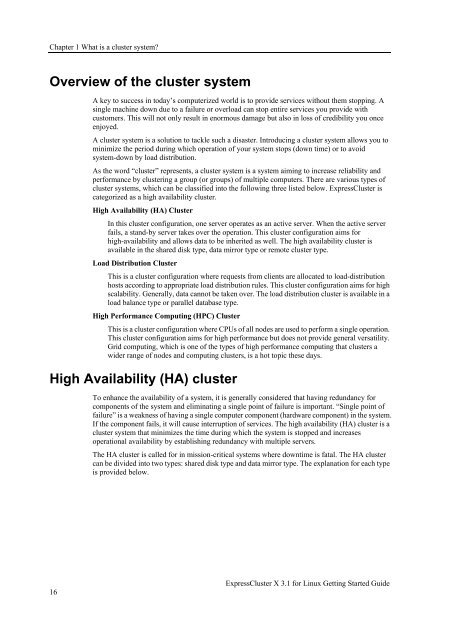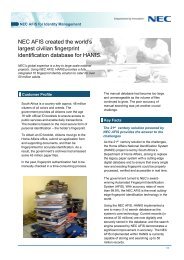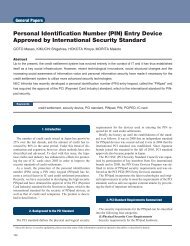ExpressCluster X 3.1 for Linux Getting Started Guide - Nec
ExpressCluster X 3.1 for Linux Getting Started Guide - Nec
ExpressCluster X 3.1 for Linux Getting Started Guide - Nec
You also want an ePaper? Increase the reach of your titles
YUMPU automatically turns print PDFs into web optimized ePapers that Google loves.
Chapter 1 What is a cluster system?Overview of the cluster systemA key to success in today’s computerized world is to provide services without them stopping. Asingle machine down due to a failure or overload can stop entire services you provide withcustomers. This will not only result in enormous damage but also in loss of credibility you onceenjoyed.A cluster system is a solution to tackle such a disaster. Introducing a cluster system allows you tominimize the period during which operation of your system stops (down time) or to avoidsystem-down by load distribution.As the word “cluster” represents, a cluster system is a system aiming to increase reliability andper<strong>for</strong>mance by clustering a group (or groups) of multiple computers. There are various types ofcluster systems, which can be classified into the following three listed below. <strong>ExpressCluster</strong> iscategorized as a high availability cluster.High Availability (HA) ClusterIn this cluster configuration, one server operates as an active server. When the active serverfails, a stand-by server takes over the operation. This cluster configuration aims <strong>for</strong>high-availability and allows data to be inherited as well. The high availability cluster isavailable in the shared disk type, data mirror type or remote cluster type.Load Distribution ClusterThis is a cluster configuration where requests from clients are allocated to load-distributionhosts according to appropriate load distribution rules. This cluster configuration aims <strong>for</strong> highscalability. Generally, data cannot be taken over. The load distribution cluster is available in aload balance type or parallel database type.High Per<strong>for</strong>mance Computing (HPC) ClusterThis is a cluster configuration where CPUs of all nodes are used to per<strong>for</strong>m a single operation.This cluster configuration aims <strong>for</strong> high per<strong>for</strong>mance but does not provide general versatility.Grid computing, which is one of the types of high per<strong>for</strong>mance computing that clusters awider range of nodes and computing clusters, is a hot topic these days.High Availability (HA) clusterTo enhance the availability of a system, it is generally considered that having redundancy <strong>for</strong>components of the system and eliminating a single point of failure is important. “Single point offailure” is a weakness of having a single computer component (hardware component) in the system.If the component fails, it will cause interruption of services. The high availability (HA) cluster is acluster system that minimizes the time during which the system is stopped and increasesoperational availability by establishing redundancy with multiple servers.The HA cluster is called <strong>for</strong> in mission-critical systems where downtime is fatal. The HA clustercan be divided into two types: shared disk type and data mirror type. The explanation <strong>for</strong> each typeis provided below.16<strong>ExpressCluster</strong> X <strong>3.1</strong> <strong>for</strong> <strong>Linux</strong> <strong>Getting</strong> <strong>Started</strong> <strong>Guide</strong>
















